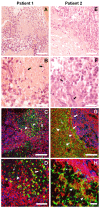A proposed role for neutrophil extracellular traps in cancer immunoediting
- PMID: 23508552
- PMCID: PMC3589747
- DOI: 10.3389/fimmu.2013.00048
A proposed role for neutrophil extracellular traps in cancer immunoediting
Abstract
Upon activation, neutrophils release fibers composed of chromatin and neutrophil proteins termed neutrophil extracellular traps (NETs). NETs trap and kill microbes, activate dendritic cells and T cells, and are implicated in autoimmune and vascular diseases. Given the growing interest in the role of neutrophils in cancer immunoediting and the diverse function of NETs, we searched for NETs release by tumor-associated neutrophils (TANs). Using pediatric Ewing sarcoma (ES) as a model, we retrospectively examined histopathological material from diagnostic biopsies of eight patients (mean ± SD age of 11.5 ± 4.7 years). TANs were found in six patients and in two of those we identified NETs. These two patients presented with metastatic disease and despite entering complete remission after intensive chemotherapy had an early relapse. NETs were not identified in the diagnostic biopsies of two patients with localized disease and two with metastatic disease. This study is the first to show that TANs in ES are activated to make NETs, pointing to a possible role of NETs in cancer.
Keywords: Ewing sarcoma; cancer; cancer immunoediting; neutrophil extracellular traps; neutrophils.
Figures

References
-
- Berghuis D., de Hooge A. S., Santos S. J., Horst D., Wiertz E. J., van Eggermond M. C., et al. (2009). Reduced human leukocyte antigen expression in advanced-stage Ewing sarcoma: implications for immune recognition. J. Pathol. 218 222–231 - PubMed
-
- Berghuis D., Santos S. J., Baelde H. J., Taminiau A. H., Egeler R. M., Schilham M. W., et al. (2011). Pro-inflammatory chemokine–chemokine receptor interactions within the Ewing sarcoma microenvironment determine CD8(+) T-lymphocyte infiltration and affect tumour progression. J. Pathol. 223 347–357 - PubMed
-
- Brinkmann V., Reichard U., Goosmann C., Fauler B., Uhlemann Y., Weiss D. S., et al. (2004). Neutrophil extracellular traps kill bacteria. Science 303 1532–1535 - PubMed
LinkOut - more resources
Full Text Sources
Other Literature Sources

